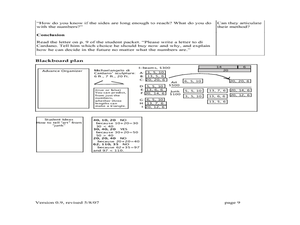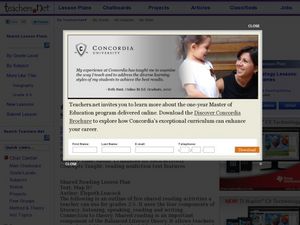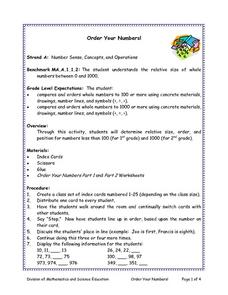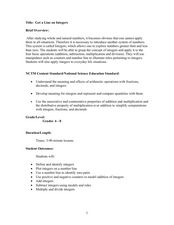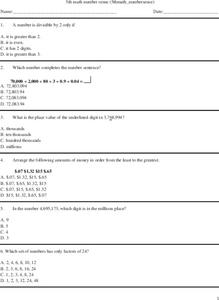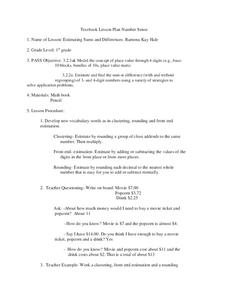Curated OER
Art or Junk? Discovering the Triangle Inequality
Middle schoolers study the triangle inequality. They will identify, compare, and analyze attributes of two and three-dimensional shapes. Then they develop vocabulary to describe the attributes. They also use manipulatives to analyze the...
Curated OER
Early Mental Math: Practice
Pupils start from a given number and count forward by 1s, 2s, and 10s. They "make ten" in 4 addition problems, and add or subtract 2 in the rest. Finally, they circle the odd numbers in a list from 1-14.
Curated OER
Decimal Models
Before jumping into numeral decimals, explore them visually using this base 10 strategy. There is a set of examples to help scholars understand the concept. They color in grids to represent decimals written in a variety of ways. Some...
Curated OER
Adding Up
Sail through the land of three addends with this nautical-themed addition learning exercise. Scholars begin by using mental math to add seven sets of three numbers located on sailboats. Next, they apply this concept to eight horizontally...
Curated OER
Sorting 3-Dimensional Shapes
The sorting is simple here: Does this three-dimensional figure have a curved surface or not? Scholars review an example before trying this on their own with nine figures including a sphere, cylinder, prism, cube,...
Curated OER
Square Corners
What type of corners does this shape have? Young geometers examine 12 shapes, circling the square corners in each if they have any. There are two examples demonstrating this concept, but be sure scholars understand the difference between...
Curated OER
States and Mates
Discuss and reflect on the concept of allies and alliances. The class examines the competition between the United States and Venezuela. Using the New York Times, they search for examples of geopolitical alliances. In addition, they write...
Curated OER
Absolute Value Bingo
Learners explore some different concepts in relation to using a number line for instruction. Given some number values, they graph the position on the number line. The lesson ends with them playing Bingo.
Curated OER
Basic Geometric Concepts - Homework 14.1
In this recognizing geometric figures worksheet, students read descriptions, draw, label, and write the names and symbols for basic geometric figures. Students solve thirteen problems.
Curated OER
Using Social Studies in Five Shared Reading Lessons: Geography
After several short 15-minute mini-lessons, your learners will gain an understanding of the characteristics of a non-fiction text. Using the book Map It by Elspeth Leacock, your class will become acquainted with non-fiction terms...
Glynn County School System
Lives and Deaths of Stars
Star light, star bright ... just how long can you wish on that star? Well, it depends on its mass. The presentation explains the life cycle of stars based on their sizes. Scholars learn about the life expectancy of a star based on the...
Purdue University
Exploring Whirligigs
What's that silly thing spinning in the wind? It's a whirligig! Explore wonderful windy whirligigs with a STEM-based unit that teaches the science and concepts behind these gigs. Scholars discover how gravity and air resistance...
Curated OER
Order Your Numbers
Students examine the order of whole numbers that range from 0 to 1,000. They compare and contrast the quantities of different numbers using the number line, objects, and symbols of comparison. Students also work as a class with cards to...
Curated OER
Get a Line on Integers
Middle schoolers explore number sense by completing math function problems in class. In this integers lesson, students define integers and practice plotting them on a number line. Middle schoolers utilize math functions such as addition...
Curated OER
The European Union
Students complete an in-depth exploration of the European Union using the five themes of geography as a guide. In small groups, students use traditional and technological resources to answer questions about the European Union, with each...
Mrs. Glosser's Math Goodies
Perimeter & Area Worksheet 2
Alternate between area and perimeter with this worksheet, practicing both concepts with different shapes. Problems include examples with parallelograms, octagons, squares, rectangles, and trapezoids. The formulas are not provided,...
Ballet Austin
The History of Modern Dance
The evolution of modern dance, and the dance history of many of the key figures in the development of this uniquely American form, are the focus of a 13-page packet that includes photos of revolutionaries.
Curated OER
Concepts of Class
For this Concepts of Class worksheet, students answer ten questions about issues and theories of class, social mobility, and social stratification.
Curated OER
Two Very Different Concepts of Time
Students explore the concept of cultural anthropology. In this culture studies instructional activity, students consider the culture of Guinea as they read "The Meaning of Time" by Katherine Ross. Students also discuss the traits of...
Curated OER
5th Grade Math Number Sense
For this grade 5 number sense worksheet, students complete a total of 25 problems covering a wide range of 5th grade math number sense concepts. Answers are included.
Curated OER
Activity #13 Changing The Look of Sugar
Students observe what happens when sugar is dissolved in water and when it is heated. They weigh the products after each of the two experiments on a balance scale. Pupils distinguish between physical and chemical changes. Students are...
Curated OER
The Three Little Pigs
Students listen two versions of the story of The Three Little Pigs in order to clarify the concept of point of view. They complete a Venn diagram and write a postcard to one of the book's characters using their point of view.
Curated OER
Number Sense
First graders practice rounding 4 digit numbers using place value concepts. In this estimating sums and differences lesson, 1st graders explore clustering, rounding, and front end estimation as methods for rounding decimals.
Curated OER
Wave Terms and Concepts
In this waves worksheet, students define 23 vocabulary words associated with the different types of waves and how waves are measured. Students complete 23 matching terms with definitions and draw the superposition of two waves shown.
